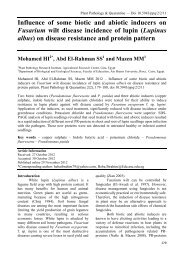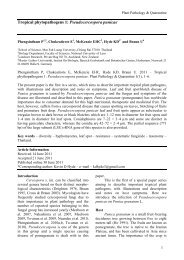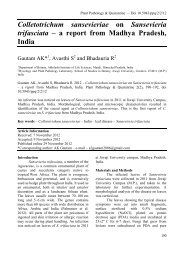Genus Cercospora in Thailand: Taxonomy and Phylogeny (with a ...
Genus Cercospora in Thailand: Taxonomy and Phylogeny (with a ...
Genus Cercospora in Thailand: Taxonomy and Phylogeny (with a ...
You also want an ePaper? Increase the reach of your titles
YUMPU automatically turns print PDFs into web optimized ePapers that Google loves.
Plant Pathology & Quarant<strong>in</strong>e<br />
Fig. 8 – Illustration of morphological structures between <strong>Cercospora</strong> <strong>and</strong> Septoria. A. <strong>Cercospora</strong><br />
christellae (To-anun et al. 2009). B. Septoria violae-patr<strong>in</strong>ii (Sh<strong>in</strong> & Sameva 2002) (arrows show<br />
the location of conidiophores <strong>in</strong>side conidiomata).<br />
& Fr.) Mont. & Fr. (≡ Cladosporium bacilligerum)<br />
as type species. This species was<br />
characterized by hav<strong>in</strong>g pigmented conidiophores,<br />
<strong>and</strong> ellipsoid-fusiform, obclavatesubcyl<strong>in</strong>dric,<br />
pigmented conidia <strong>with</strong> (0-)1(-3)septa<br />
(basal clade, Fig. 7). The basal position<br />
of Passalora clade <strong>in</strong>dicated that species <strong>in</strong><br />
Passalora hold more plesiomorphic characters<br />
or ancestral state characters than other<br />
cercosporoid fungi clades. This <strong>in</strong>dication was<br />
also reported earlier by Stewart et al. (1999).<br />
On the other h<strong>and</strong>, species <strong>with</strong><strong>in</strong> Pseudocercospora<br />
s. str. form a monophyletic clade<br />
wth 95% bootstrap support <strong>and</strong> appear as a<br />
sister group to Stigm<strong>in</strong>a clade <strong>with</strong> 60% bootstrap<br />
support (Fig. 7). Morphologically, these<br />
two genera are similar <strong>in</strong> hav<strong>in</strong>g holoblastic<br />
<strong>and</strong> term<strong>in</strong>al conidia. proliferation, as well as<br />
obclavate to filiform-acicular <strong>with</strong> truncate<br />
base <strong>and</strong> multiseptate conidia, However, they<br />
differs due to the conidia of Stigm<strong>in</strong>a be<strong>in</strong>g<br />
verrucose, dark brown <strong>and</strong> sometimes produc<strong>in</strong>g<br />
longitud<strong>in</strong>al septa, which is quite dist<strong>in</strong>ct<br />
to Pseudocercospora s. str. which has<br />
smooth <strong>and</strong> subhyal<strong>in</strong>e conidia <strong>with</strong> only transverse<br />
septation, <strong>and</strong> unthickened conidial loci<br />
<strong>and</strong> hila. Pseudocercospora s. lat. is morphologically<br />
highly variable, <strong>and</strong> accommodates a<br />
wide range of cercosporoid hyphomycetes <strong>with</strong><br />
pigmented conidiophores <strong>and</strong> <strong>in</strong>conspicuous,<br />
unthickened <strong>and</strong> not darkened conidiogenous<br />
loci. It <strong>in</strong>cludes Paracercospora, Phaeoisariopsis,<br />
Stigm<strong>in</strong>a <strong>and</strong> Pseudophaeoramularia<br />
(Crous et al. 2001). Crous et al. (2000) showed<br />
Pseudocercospora s. lat. to be polyphyletic<br />
<strong>with</strong><strong>in</strong> Mycosphaerella anamorphs, hav<strong>in</strong>g<br />
evolved more than once from different Mycosphaerella<br />
holomorphs, <strong>and</strong> <strong>in</strong> several occasions<br />
hav<strong>in</strong>g lost the teleomorph (Crous &<br />
Braun 2003). This complex <strong>in</strong>cludes genera<br />
<strong>with</strong> s<strong>in</strong>gle to synnematous (Phaeoisariopsis)<br />
conidiophores, solitary or catenate (Pseudophaeoramularia)<br />
conidia, eu- (Pseudocercospora)<br />
or distoseptate (Stigm<strong>in</strong>a), <strong>and</strong> scars<br />
which are <strong>in</strong>conspicuous to denticle-like<br />
(Denticularia <strong>and</strong> Semipseudocercospora), unthickened<br />
to slightly pigmented conidia (Paracercospora)<br />
(Crous & Braun 2003).<br />
With<strong>in</strong> <strong>Cercospora</strong> species (<strong>Cercospora</strong><br />
s. str.), Crous & Braun (2003) stated the need<br />
of a “compound species”, a species that is<br />
formed when two or more species jo<strong>in</strong> together<br />
because of <strong>in</strong>dist<strong>in</strong>guishable <strong>in</strong> morphology or<br />
genetic or physiology characteristics, named C.<br />
apii s. lat., compris<strong>in</strong>g all cercosporoid hyphomycetes<br />
<strong>in</strong>dist<strong>in</strong>guishable from the <strong>Cercospora</strong><br />
23









